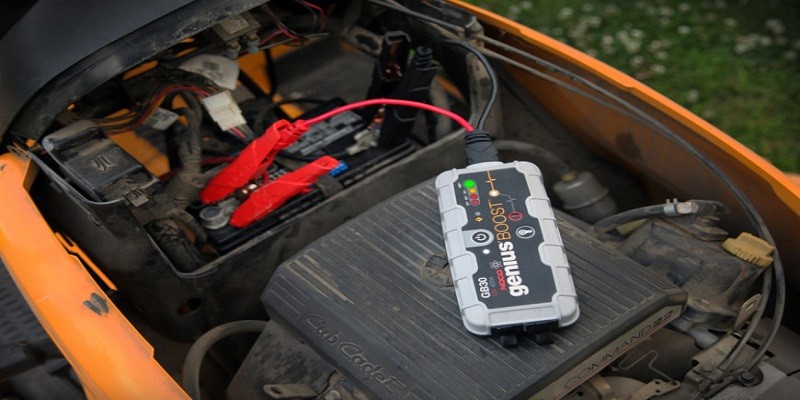Last Updated on January 15, 2025
To change a battery in a lawnmower, follow these steps: First, locate the battery compartment in the lawnmower. Then, carefully disconnect the old battery, ensuring you don’t damage any connections.

Credit: knowhow.napaonline.com
Getting Started With Changing Your Lawnmower Battery
Learn how to change the battery in your lawnmower with these simple steps. Keep your lawnmower running smoothly and efficiently by following this easy guide.
If your lawnmower is not starting or holding a charge, it might be time to change the battery. Before you begin, it’s important to determine if your lawnmower indeed requires a battery change. Gather the necessary tools and materials and make sure to follow safety precautions.
Let’s walk through the steps to get you started on changing the battery in your lawnmower.
Determine If Your Lawnmower Requires A Battery Change:
- Check if your lawnmower is not starting or fails to hold a charge.
- Consult the user manual of your lawnmower to see if it has a battery and how to troubleshoot battery-related issues.
- Pay attention to any warning lights or indicators on your lawnmower that might suggest a battery problem.
Gather The Necessary Tools And Materials:
- Screwdriver: To remove any battery-related covers or panels.
- Socket wrench: To loosen and remove the terminal cables.
- New battery: Make sure it is compatible with your lawnmower and has the correct voltage and size.
- Safety goggles and gloves: To protect your eyes and hands during the process.
Ensure Safety Precautions Are In Place:
- Make sure your lawnmower is turned off and the engine is cool before you begin.
- Disconnect the spark plug to prevent accidental engine starts.
- Work in a well-ventilated area to avoid inhaling any fumes emitted by the battery.
- Keep a fire extinguisher nearby, especially if you are working in an enclosed space such as a shed or garage.
Now that we’ve covered the initial steps, you’re ready to start changing the battery in your lawnmower. Remember to refer to the specific instructions provided in your lawnmower’s user manual for any model-specific details. Stay safe and ensure all steps are followed carefully to successfully replace your lawnmower battery.
Assessing Your Lawnmower Battery
Assessing and changing your lawnmower battery is a simple task that can be done with a few easy steps. By following the right guidelines, you can ensure a smooth and efficient battery replacement process for your lawnmower.
Is your lawnmower battery giving you trouble? If your lawnmower is struggling to start or losing power quickly, it may be time to change the battery. Assessing the condition of your lawnmower battery is the first step in determining if a replacement is needed.
Here’s how you can assess your lawnmower battery:
Locate The Battery Compartment
- Begin by locating the battery compartment on your lawnmower. The location can vary depending on the make and model of your mower, but it is typically found either under the hood or behind the mower seat.
Perform A Visual Inspection Of The Battery
- Once you’ve located the battery compartment, visually inspect the battery for any signs of damage or corrosion. Look for cracks, leaking acid, or a swollen appearance, as these are indicators that your battery may need replacing.
- Check for any loose or corroded connections on the battery terminals. Corrosion can hinder the battery’s performance, so make sure to clean any buildup with a battery terminal cleaner and wire brush.
Test The Battery’S Voltage
- To assess the battery’s charge, you’ll need a multimeter or voltage tester. Set the tester to the DC voltage setting and connect the positive (red) probe to the positive terminal on the battery and the negative (black) probe to the negative terminal.
- A fully charged battery should read around 12.6 to 12.8 volts. If the reading is below 12.4 volts, it may indicate a weak battery that needs to be replaced.
Understand The Type Of Battery Your Lawnmower Uses
- It’s essential to know the type of battery your lawnmower uses to ensure you purchase the correct replacement. Common types include lead-acid, lithium-ion, and gel-cell batteries. Consult your lawnmower’s manual or contact the manufacturer to determine the appropriate battery type.
- Consider factors like the battery’s size, voltage, and terminal configuration when selecting a replacement. If in doubt, take the old battery with you when purchasing a new one to ensure compatibility.
Assessing your lawnmower battery is the first step before deciding whether a replacement is necessary. By locating the battery compartment, performing a visual inspection, testing the battery’s voltage, and understanding the battery type, you can make an informed decision to keep your lawnmower running smoothly.
Removing And Replacing The Old Battery
To change the battery in a lawnmower, start by removing the old battery carefully. Then, replace it with a new one, ensuring it is securely installed. Enjoy a smoothly functioning lawnmower with this simple battery change.
Replacing the battery in your lawnmower is a simple task that can be done in just a few steps. Whether your battery is dead or you simply want to upgrade to a new one, here’s how you can remove and replace the old battery:
Disconnect The Battery Cables:
- Start by putting on a pair of gloves to protect your hands from any potential electric shocks.
- Locate the battery in your lawnmower. It is usually situated near the rear or under the seat.
- Identify the battery cables, which are typically red (positive) and black (negative).
- Use a wrench or pliers to loosen the nuts on the battery terminals.
- Once loosened, carefully remove the negative cable (black) followed by the positive cable (red).
Safely Remove The Old Battery From Its Compartment:
- Lift the old battery out of its compartment using both hands.
- Be cautious as the old battery can be heavy, so it’s essential to have a firm grip.
- Place the old battery aside in a safe area away from direct sunlight or any flammable materials.
Clean The Battery Terminals:
- Examine the battery terminals for any corrosion or dirt buildup.
- If you notice any grime or corrosion, mix a solution of baking soda and water in a small container.
- Dip an old toothbrush into the solution and scrub the battery terminals to remove any corrosion or dirt.
- Once clean, rinse the terminals with water and dry them thoroughly with a clean cloth.
Install The New Battery And Secure It Properly:
- Take the new battery and carefully position it in the battery compartment.
- Ensure that the positive terminal (+) aligns with the red cable and the negative terminal (-) aligns with the black cable.
- Double-check that the battery is securely placed in the compartment and won’t move around during operation.
Reconnect The Battery Cables:
- Start by reconnecting the positive cable (red) to the positive terminal (+) on the new battery.
- Tighten the nut on the terminal using a wrench or pliers, making sure the connection is secure.
- Next, reconnect the negative cable (black) to the negative terminal (-) on the new battery.
- Again, tighten the nut on the terminal to ensure a firm connection.
By following these simple steps, you can easily remove and replace the old battery in your lawnmower. Remember to dispose of the old battery properly and enjoy the improved performance of your lawnmower with a brand new battery.
Testing And Maintenance
Looking to change the battery in your lawnmower? Follow these easy steps for testing and maintenance to keep your lawnmower running smoothly.
Perform A Battery Voltage Test After Installation
After installing a new battery in your lawnmower, it is essential to perform a battery voltage test to ensure that everything is working correctly. This test will give you confidence in your new battery and help identify any potential issues early on.
Here’s how you can perform a battery voltage test:
- Gather the necessary tools: You will need a voltmeter or multimeter to measure the battery voltage accurately.
- Turn off the lawnmower: Make sure the lawnmower is turned off before starting the voltage test to avoid any mishaps.
- Connect the voltmeter: Attach the voltmeter’s positive (red) probe to the positive terminal of the battery and the negative (black) probe to the negative terminal.
- Read the voltage: The voltmeter will display the voltage reading. A healthy lawnmower battery should have a voltage reading between 12.4 and 12.7 volts.
- Interpret the results: If the voltage reading is below 12.4 volts, it indicates a low or discharged battery that may need charging or replacement.
Performing a battery voltage test after installation is crucial to ensure that your lawnmower’s battery is functioning properly and ready for use.
Properly Maintain Your Lawnmower Battery
To prolong the life of your lawnmower battery and ensure its optimal performance, regular maintenance is key. Follow these simple tips to properly maintain your lawnmower battery:
- Clean the battery terminals: Over time, corrosion can build upon the battery terminals, hindering the flow of electricity. Use a wire brush to clean the terminals, and ensure they are free from any dirt or debris.
- Check the electrolyte levels: If you have a traditional lead-acid battery, it’s essential to check the electrolyte levels regularly. Ensure that the fluid level is above the battery plates but below the fill line, and add distilled water if necessary.
- Keep the battery charged: Regularly charge your lawnmower battery to maintain its charge and prevent it from becoming completely discharged. Avoid leaving the battery partially charged for extended periods, as it can shorten its lifespan.
- Store the battery properly: If you’re storing your lawnmower during the off-season, it’s important to remove the battery and store it in a cool, dry location. Remember to keep it in a place where it won’t freeze or come into contact with extreme heat.
By following these maintenance tips, you can extend the life of your lawnmower battery and ensure it performs optimally when you need it the most.
Troubleshoot Common Issues Related To The Battery
Dealing with battery-related issues can be frustrating, but understanding common problems and their possible solutions can save you time and money. Here are some troubleshooting tips for common lawnmower battery issues:
- Battery not starting the lawnmower: Check the battery connections to ensure they are secure and free from corrosion. If the connections are fine, test the battery voltage using a voltmeter. A low voltage reading indicates the need for charging or battery replacement.
- Battery not holding a charge: If your lawnmower battery loses its charge quickly, there may be an issue with the charging system. Check the alternator, voltage regulator, and wiring for any faults. Also, make sure the battery is in good condition and not nearing the end of its lifespan.
- Slow cranking or weak start: If your lawnmower is struggling to start, it could be due to a weak battery. Test the battery voltage and replace it if necessary. Additionally, inspect the starter motor and ignition system for any faults that may be affecting its performance.
By troubleshooting these common battery issues, you can identify the root cause and take the appropriate steps to get your lawnmower running smoothly again.
Extend The Lifespan Of Your Lawnmower Battery
To make the most out of your lawnmower battery and extend its lifespan, implementing some best practices is essential. Follow these tips to ensure longevity:
- Avoid deep discharges: Try to avoid fully discharging the battery, as it can cause irreversible damage. Recharge the battery before it reaches a critically low voltage to maintain its health.
- Regularly charge the battery: Keeping your lawnmower battery charged is crucial for its longevity. When the lawnmower is not in use, recharge the battery once a month, or follow the manufacturer’s recommendations.
- Protect from extreme temperatures: Exposure to extreme heat or cold can deteriorate the battery’s performance and lifespan. Store the lawnmower in a protected area, and if necessary, consider using a battery insulation kit to protect it from temperature extremes.
- Use a battery maintainer: Consider investing in a battery maintainer or trickle charger to keep your lawnmower battery in top condition during periods of extended inactivity.
By following these practices, you can significantly extend the lifespan of your lawnmower battery, ensuring reliable performance season after season.
Frequently Asked Questions For How To Change A Battery In A Lawnmower?
How Do I Change The Battery In My Lawnmower?
To change the battery in your lawnmower, follow these steps: 1. Disconnect the spark plug wire for safety. 2. Locate the battery on your lawnmower. 3. Remove any protective coverings or terminals connected to the battery. 4. Take out the old battery carefully.
5. Insert the new battery, ensuring a proper fit. 6. Reattach any terminals or coverings that were removed. 7. Reconnect the spark plug wire. 8. Test the lawnmower to ensure the new battery is working properly. Remember to always refer to your lawnmower’s manual for specific instructions.
Which Terminal Do You Disconnect First On A Lawn Mower Battery?
Disconnect the negative terminal first on a lawn mower battery for safety reasons.
Can You Jump Start A Dead Mower Battery?
Yes, you can jump start a dead mower battery by connecting it to another working battery.
How Do You Reconnect A Lawnmower Battery?
To reconnect a lawnmower battery, follow these steps: 1. Turn off the lawnmower and locate the battery. 2. Remove any protective covers or terminals from the battery. 3. Match the positive (+) and negative (-) terminals on the battery with the corresponding cables.
4. Connect the positive cable to the positive terminal and the negative cable to the negative terminal. 5. Tighten the cable clamps securely. 6. Replace any protective covers or terminals that were removed. 7. Turn on the lawnmower to test if the battery is properly connected.
How Often Should I Change The Battery In My Lawnmower?
It is recommended to change the battery in your lawnmower every one to two years for optimal performance.
Conclusion
Changing the battery in a lawnmower is a straightforward process that can be done by following a few simple steps. By ensuring proper safety measures are taken, such as disconnecting the spark plug and wearing protective gloves, anyone can easily replace a lawnmower battery.
Firstly, locating the battery compartment and removing the old battery is crucial. Next, connecting the new battery correctly and securely is essential for optimal performance. It’s important to keep in mind that different lawnmower models may have slightly different battery replacement procedures, so always consult the manufacturer’s instructions for specific guidance.
Regularly maintaining and replacing the battery when necessary will help ensure the lawnmower operates efficiently and for a longer period. By following these steps and proper maintenance routines, your lawnmower will be ready to tackle any yard work with a fully charged battery.







